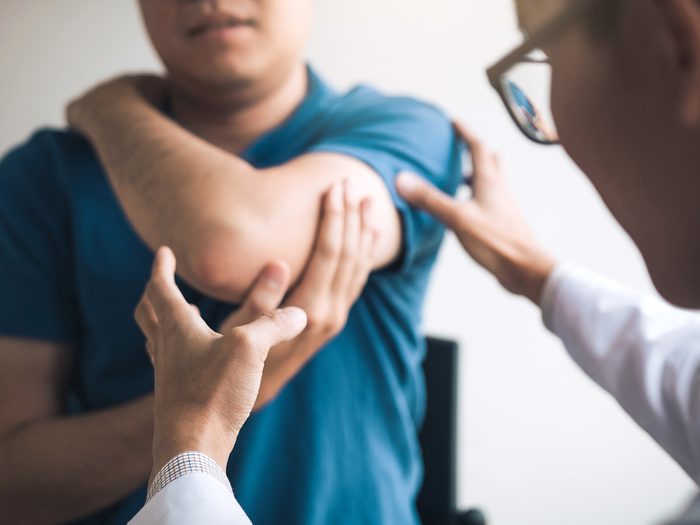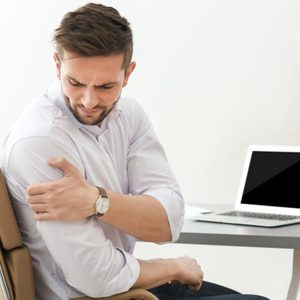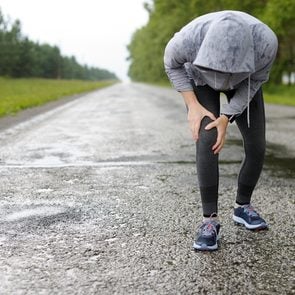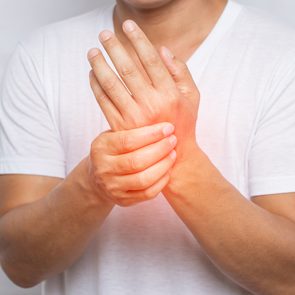If You Suffer From Arthritis Pain, These Treatments Are Your Best Bet

Innovative approaches to pain relief—and even potential cures for osteoarthritis—are on the horizon.
It might be in yoga class when you first feel it—when did downward dog start getting so hard on the wrists? Or it could be at your weekly squash or tennis game that you notice your knees screaming back at you whenever you pivot. Chances are, it’s arthritis, which isn’t just an “old-people” problem: It usually kicks in between the ages of 40 and 60.
By far the most common type of arthritis is osteoarthritis. It’s usually the result of decades of physical activity that wears down the cartilage in our joints. That’s the rubbery, frictionless tissue that acts as a shock-absorber between bones. After years of wear and tear, or an injury such as a fracture or dislocation, that cushion can harden and fray like a dried-out rubber band, causing the entire joint to become inflamed and painful (the word arthritis comes from the Greek arthro, which means “joint,” and itis, which means “inflammation”).
Osteoarthritis, or OA, is diagnosed in two-thirds of people who experience any sort of joint pain. According to a national survey done in 2022 by the University of Michigan, 30 percent of Americans between the ages of 50 and 80 report doctor-diagnosed OA (eight percent of respondents were diagnosed with rheumatoid arthritis, which is an autoimmune disease). Women are more likely to suffer from it than men, for reasons that remain unclear. The World Health Organization estimates that 528 million people worldwide have OA, and an increase over the next decade is projected as the population ages.
The joints that bear the brunt of OA are most often the knees, knuckles, base of the thumb, lower back and hips. Sufferers might notice swelling or even feel a grating sensation in the joints, and some people experience aching that’s deep enough to wake them up at night. Stiffness is common, particularly in the morning, and things like opening a jar or bending down aren’t as easy as they used to be.
Fortunately, relief for arthritis pain in the form of some innovative solutions may be on the way.
Finding relief for arthritis pain
Maintaining a healthy body weight helps, since it’ll mean less load on your joints. Keeping extra weight off also minimizes your risk of getting OA in the first place. Exercise is often the first treatment doctors suggest. If you’re not already active, low-impact options like walking, biking or swimming are good ways to start moving more. Exercise helps ward off stiffness and keeps muscles supple around the joint.
Yoga might bring relief for arthritis pain, too, according to the Arthritis Foundation. Experts there also recommend seeing a physiotherapist, who can teach you some movements to improve mobility and increase your strength to support the affected joints. But most people find that these things don’t eliminate pain, or they help only if symptoms are mild to moderate.
Find out if chair yoga is right for you.

Over-the-counter pain relievers, such as ibuprofen and naproxen, relieve pain and stiffness, but aren’t a long-term solution because they can irritate the stomach. Doctors might prescribe an oral corticosteroid such as prednisone, but it can cause side effects such as weight gain, mood swings and high blood pressure, so it should be used only briefly.
For some, corticosteroid injections can offer temporary relief for arthritis pain, but two recent studies, one from the University of California, San Francisco, and the other from Rosalind Franklin University of Medicine and Science in Chicago, found that they might actually lead to a progression of OA.
Doctors may also recommend hyaluronic acid, which is injected into the joint to act as a viscous fluid replacement for the cartilage, like oil in a car engine. But it’s no cure. While the injection may temporarily relieve pain and even slow down progression of the disease, according to a landmark study published in the BMJ last year, it provides little to no long-term benefit for most patients.
Another injectable treatment, which has been used since the 1980s to treat torn tendons and joint injuries, is platelet-rich plasma. Your own blood is removed, enriched with platelets and then injected. Some athletes have tried it for sports injuries—notably, Tiger Woods. But it appears to have mixed success, according to the American Journal of Sports Medicine, and much more research is needed to find out how to make it work better.
So far, the only truly effective osteoarthritis treatment is a complete joint switch-out, whether it’s the replacement of knuckles, knees or hips. Millions of people around the world undergo the surgery, but the catch is that the new joints last only so long—15 to 20 years—so many doctors don’t recommend it for anyone who is under the age of 60.
Combined treatments
Ben Bebenroth, a Cleveland, Ohio-based farm-to-table chef, didn’t have much relief from arthritis pain until he underwent knee-replacement surgery. His osteoarthritis started when he was 15, after he injured his left knee in a snowboarding accident. For a long time, he self-medicated with alcohol and over-the-counter painkillers so he could keep up with his busy lifestyle and stay active. “I dealt with my pain that way for 25 years,” says the now 45-year-old, a former Marine.
Aside from exercising and keeping his weight in check, he tried hyaluronic acid injections, steroid injections and even three arthroscopic, or “keyhole,” surgeries (sometimes recommended in cases where the OA was caused by injury). Nothing worked. Finally, Bebenroth underwent a total knee replacement at the unusually young age of 40. “When you reach the point of bone-on-bone contact, you just grin and bear it until you can’t anymore,” he explains.
Bebenroth knows it’s inevitable that he’ll develop some degree of arthritis in his right knee—that’s what happens if one joint takes the brunt of wear and tear when the injured one is long favoured—but in the meantime the surgery has allowed him to return with new enthusiasm to his work, and to the hiking and snowboarding he loves.

He also avoids all sugar and alcohol, and supplements his diet with nutrient-dense, anti-inflammatory foods like turmeric and ginger from his organic farm, where he grows ingredients he uses at his restaurant. Featuring many foods from the Mediterranean diet—fish, nuts, beans, lean meats, lots of leafy vegetables—an anti-inflammatory diet is well established as being joint friendly.
“Diet has been critical,” Bebenroth says. “The fewer inflammatory foods I eat, the better I feel.” Stretching, meditation and movement have also helped. “This way of living helps me move away from being in a reactive state, when you’re angry at your pain and end up soothing yourself with a sweet treat.”
Here’s what can happen when you start meditating every day.
New hope for OA sufferers
Given how many people suffer from OA around the world, a lot of researchers are working on solutions—and are at last finding some. At Duke University, for example, researchers are planning to launch a clinical trial this year for a knee gel made of water-absorbing polymers that simulates cartilage.
Using stem cells derived from our own bodies to treat arthritis also shows promise. In 2018, researchers at Stanford University School of Medicine managed to isolate skeletal stem-cells in adult humans, a significant step toward regenerating cartilage.
“We thought skeletal stem cells existed for some time, but we weren’t sure,” says Charles Chan, an assistant professor of surgery at Stanford. “We used a technique called FACS, which is sort of like a jelly bean sorter. It allows us to separate types of cells based on the protein on their surface. There were around 100 types.”
To understand which was which, the researchers transplanted the cells into mice to see what they differentiated into. Some turned into bone.
Chan and his colleagues then discovered that they could foster the growth of new cartilage with these cells by sending them a new set of instructions. In their experiments, they created a microfracture by drilling a tiny hole in bone tissue. “This provokes skeletal stem cells to gush up in a blood clot,” Chan explains. “Left on its own, this would turn into scar tissue, or what we call fibrocartilage. It acts like a Band-Aid, holding everything in place. But it’s not as bouncy or slippery as regenerated cartilage.”
What if, the team wondered, they somehow changed the chemical signalling that was telling the cells what to do? “We thought maybe we could interrupt the cells as they developed into cartilage on their way to becoming bone—coax them to finish their work at the cartilage stage,” explains Chan. The chemicals the team used to try this have prior approval and safety profiles from the FDA for other applications, such as Avastin for various cancers.

It worked. The result of their experiment in laboratory mice, and then in human joint tissue infused into mice, “is that you get a nice piece of cartilage,” Chan says. “It’s durable. And the subjects get dramatic improvements in their pain and their movement.”
The team is now raising funds for human clinical trials, where they plan to start with osteoarthritis in patients’ thumbs and fingers. If all goes well, they may be able to bring an injectable medication to market that doesn’t just provide relief for arthritis pain but actually cures the disease.
Read up on how stem cell therapy is saving lives.
Innovations in relieving arthritis pain
Meanwhile, the Melbourne Stem Cell Research Centre in Australia has conducted a number of trials on the use of adipose- (fat-) derived stem cells in the treatment of osteoarthritis. Similar experiments are taking place in Italy and Ireland. The idea is to work with our mesenchymal stem cells (MSCs), which are important for making and repairing cartilage and bone. They seem to have multiple positive effects, including calming inflammation set off by the body’s immune response and reducing nerve pain.
“Patients undergo a mini-liposuction,” says principal investigator Julien Freitag, a Melbourne-based musculoskeletal specialist. Then, the fat tissue is transferred to an accredited laboratory, where the MSCs are expanded and injected into a patient’s joint; a second injection is given six months later.
While it remains somewhat unclear exactly how MSCs weave their healing magic, says Freitag, “our clinical research conducted over the last nine years has been incredibly promising.” That research, which includes a randomized controlled trial and data collected from actual cases, shows pain reduction and improvements in joint function. “We are seeing significant benefit to patients, whether they have mild, moderate or severe osteoarthritis.”
Given that other research centres are also deep into treatment research, a government-approved breakthrough therapy will probably emerge in the next 10 to 15 years. If it proves to be as safe and effective as it has been in research so far, millions of sidelined athletes will be able to get back out onto the field, or just enjoy everyday life more.
Next, find out if cherry juice really provides relief for arthritis pain.






